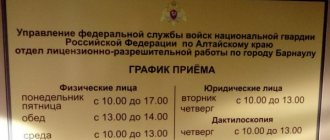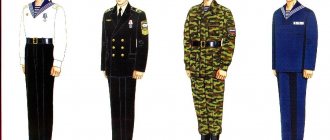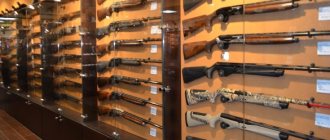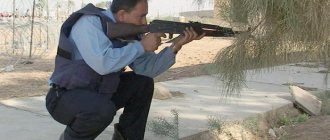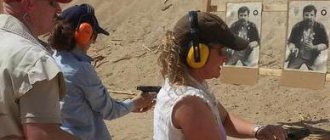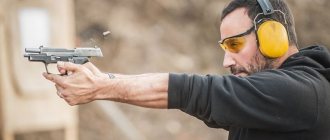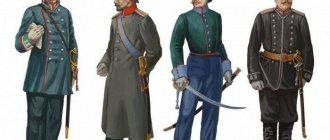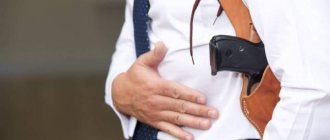Police officers are required to follow certain rules and requirements regarding the wearing of uniform at different times of the year and for different occasions.
Dear readers! The article talks about typical ways to resolve legal issues, but each case is individual. If you want to find out how to solve your particular problem , contact a consultant:
+7 (499) 938-81-90 (Moscow)
+7 (812) 467-32-77 (Saint Petersburg)
8 (800) 301-79-36 (Regions)
APPLICATIONS AND CALLS ARE ACCEPTED 24/7 and 7 days a week.
It's fast and FREE !
The management clearly regulates and controls the implementation of these rules. In this material we will provide you with the basic rules for wearing uniforms by police officers in the Russian Federation in 2022, which apply to all units in all regions of the Russian Federation.
Rules for wearing uniforms by employees of the Ministry of Internal Affairs
The police are practically the internal army of Russia with all the ensuing consequences. Namely, strict chain of command, military ranks and a special code of honor.
Wearing uniforms is one of the main differences between employees of the Ministry of Internal Affairs. Police and traffic police officers have strict regulations regarding official clothing, violation of which is subject to penalties.
Types of uniforms and insignia are regulated by Order of the Ministry of Internal Affairs No. 575 of July 26, 2013, as well as by Decree of the Government of the Russian Federation No. 853. The uniform has a certain variety of colors and styles, but the wearing and combination of various parts of the wardrobe has clear instructions that cannot be violated. Next, we will talk about how to wear the Ministry of Internal Affairs uniform and how to properly attach awards to it.
Types of uniforms
The uniforms of the Ministry of Internal Affairs are made from gray or blue-gray fabric. There are summer, winter and demi-season sets. Chevrons, shoulder straps and other insignia corresponding to the rank are sewn onto the uniform.
Wearing rules are strictly regulated. In addition to clear instructions, the government regulations contain images that clearly demonstrate the order and location of all distinctive signs. In addition, there is an instruction that uniforms must be kept clean, ironed and fit properly.
There are several types of form:
- Casual. Used every day.
- Special. For special assignments.
- For service on the street. Used for cordons and other special operations.
- Day off. Worn for the oath, parades and on guard duty.
Each type of uniform has both a summer and a winter version. The transition between winter/summer occurs simultaneously throughout the entire territory of the Russian Federation, regardless of the climate zone.
Interestingly, the uniform cannot be worn outside of duty. If a law enforcement officer is seen dressed in uniform in an entertainment establishment, he will most likely be punished. In addition, women are prohibited from wearing too bright makeup and flashy jewelry.
How to wear a uniform
The Ministry of the Interior has developed strict rules that regulate all aspects of wearing uniforms. For example, you cannot wear earflaps with an autumn jacket, or a summer headdress with a winter pea coat.
This also applies to the combination of elements belonging to different types of form. That is, a dress jacket cannot be worn with casual trousers, and a winter hat cannot be worn with a summer T-shirt, etc.
Rules for wearing the uniform:
- Shoes must be black. Women are allowed to wear low heels.
- The cap is worn so that the visor is slightly tilted to the right and is at eyebrow level. The earflaps cannot be more than 20-30 mm below the eyebrows.
- Uniforms must be buttoned all the way to the top.
- Trousers should only be tucked into high boots or boots.
- If it's hot, it's okay to roll up your sleeves a little.
- The skirt cannot be above or below the knee.
- The shirt comes with a tie, which you don’t have to wear in the summer.
These are not all the rules that the government has developed for police uniforms. The full list can be found in the official government regulations.
Rules for attaching insignia
Army photos on Shutterstock: Army and military photos.
The new regulations stipulate not only the rules for wearing clothes, but also how and where to attach chevrons, shoulder straps and other insignia. Let us note that by order of the Ministry of Internal Affairs, wearing insignia is mandatory, and there are also strict regulations in this regard:
- Shoulder straps must be on shirts and all outerwear. They can either be sewn on or attached with Velcro.
- The standard size of insignia is 12x7.5 cm.
- The inscription "Police" is located at the top left, as well as in large letters on the back.
- Special identifying marks are attached to the left pocket. If strips are used, they are placed 1 cm below the left pocket.
- Awards are attached to the left, observing the hierarchy.
All insignia are attached so that there are gaps of a certain size between them. For example, for signs of the Ministry of Internal Affairs of the Russian Federation it is 5 cm.
Conclusion
That's all the basic rules for wearing the uniform of the Ministry of Internal Affairs. Of course, we talked about this in a condensed form. If we list all the intricacies of wearing a uniform and insignia, the article will turn out to be several pages long. If you are interested in this topic, study the official document on the Ministry of Internal Affairs website.
What has the Government provided?
In 2011, the government of the Russian Federation issued Resolution No. 835, which talks about the features of official clothing for men and women, the distinctive features of the components of the uniform depending on rank and position, provides a definition of the uniform, and a description of the types of shoulder straps.
The document establishes standards according to which police officers should be provided with things in times of peace.
General provisions
The main provisions of the above Resolution establish:
- Wearing a uniform provides for differences based on the specific rank of the employee
- In addition to uniforms, the clothing set also includes appropriate equipment
- Essential features of official clothing: established types of shoulder straps, accessories, combinations of combinations, colors and various components of uniform
Types of uniforms
Casual and dress uniforms are divided into clothes for summer and winter, which in turn imply a difference between men's and ladies' uniforms.
The male uniform of an employee of the Ministry of Internal Affairs includes:
- Ushanka made of sheep fur in a dark blue shade with a cockade sign
- Gray astrakhan hat with earflaps (for persons of higher ranks)
- Steel-colored wool cap with visor
- Dark blue wool cap with matching piping and badge. For senior positions, gold embroidery and intertwined cords are provided
- Cap for summer
- caps for autumn and winter
- Blue wool coat
- sheep collar
- Autumn jacket made of wool. Shoulder straps are provided for general officers
Leather jacket.- Autumn blue raincoat with shoulder straps
- Membrane waterproof suit
- Winter set with shoulder straps and edgings
- Summer blue set with shoulder straps
- Dress jacket made of steel gray wool
- Wool jacket with piping and shoulder straps
- Wool jacket
- Wool sweater
- Wool blue trousers
- White and blue-gray shirt with shoulder straps
- Blue tie with clasp
- White and blue scarves
- T-shirts and T-shirts in light and dark shades
- Golden belt
- Belt and belt
- Black boots
- Black ankle boots
- Winter ankle boots
- Winter boots and autumn ankle boots
- Socks
- two pairs of dark and white gloves
For the women's version, shirts are replaced with blouses, a cap with a hat, caps, dresses, jackets, skirts and shoes are added.
Separately, there is a patrol uniform and clothing for employees supervising traffic regulations and holding special ranks.
How to wear insignia and chevrons?
Sometimes it is allowed to wear the insignia of the previous design on a new uniform. In ordinary cases, the established procedure should be followed. It is spelled out in detail in the above Rules.
Special sleeve insignia measuring 12 by 7.5 centimeters are also attached in a certain way.
The chevron of the special rank holder looks like this:
- triangular shape with rounded top
- red border with silver inscription “Ministry of Internal Affairs”
- above the triangle in a red frame there is a white inscription “Police”
- in the middle of the triangular shield of the armlet there is a symbol of a double-headed eagle with three crowns
For the chevrons of other employees, images of a warrior who defeats a dragon and a hexfeather against the background of swords, a round shield with a laurel wreath, a railway wheel against the background of an anchor, a key against the background of a fortress, an image of a book and a laurel wreath are also used. There are special patches for aviation and riot police officers .
Features of the form and its distinctive elements
- Police officers with special ranks wear a certain set of uniforms.
- A distinctive feature is a noticeable red edging
- Traffic police officers wear uniforms containing reflective elements
- Gray-blue piping distinguishes the uniform of justice employees
- Special uniforms in colors that allow camouflage are allowed to be worn by employees of agencies carrying out their service in emergencies, in areas of armed action and other hot spots
The distinctive features of the form should be understood as five-pointed stars of various colors and materials, as well as black and gold plates.
Each rank has its own size and type of distinctive feature. For example, on the general’s shoulder straps you can see an embroidered star with a diameter of 4 cm.
Insignia placed on employee shoulder straps:
- General of the Police of the Russian Federation - a star with a red edge;
- Colonel General - 3 stars with or without edges;
- Lieutenant General - a pair of stars with or without edging;
- major general - 1 star;
- colonel - 3 stars in a certain sequence
- police lieutenant colonel - 2 stars.
The distinctive features of special ranks are not placed on the shoulder straps of privates.
Order of the Ministry of Internal Affairs of the Russian Federation dated July 26, 2013
2. Heads (chiefs) of divisions of the central apparatus of the Ministry of Internal Affairs of Russia, territorial bodies of the Ministry of Internal Affairs of Russia at the district, interregional and regional levels, educational institutions, research, medical, sanitary and sanatorium organizations of the Ministry of Internal Affairs of Russia, district departments of material and technical supply of the system The Ministry of Internal Affairs of Russia, other organizations and divisions created to perform the tasks and exercise powers assigned to the internal affairs bodies of the Russian Federation:
5. Employees wear special clothing, special shoes and safety equipment required by the relevant supply standards to protect them from adverse environmental influences and ensure the performance of their official and special duties, including when servicing equipment and service animals.
Rules for wearing police uniforms in 2018
The methods of wearing uniforms by employees of internal affairs bodies, the types of uniforms they use, and the types of insignia are regulated by Order of the Ministry of Internal Affairs No. 575 of July 26, 2013 and Government Decree No. 853. Variety is allowed in the wardrobe, but it is strictly regulated. What are the rules for wearing uniforms for police officers?
Rules for wearing police uniforms
The daily uniform of employees of the Ministry of Internal Affairs is allowed in a gray or gray-blue shade; it must correspond to the assigned rank. The sets are distinguished by season (winter/summer), for each department there are separate insignia, standard chevrons, sleeve stripes, shoulder straps, and other elements.
The specifics of wearing clothing items are clearly stated in the regulations; there are images that clearly demonstrate how to properly secure certain elements. Drawings help to visually perceive information, place all the required attributes in the correct order, following the sequence provided in the places.
Modern legislation makes the use of uniforms a mandatory requirement for any employee, with the exception of operatives and psychologists. The owner must ensure that the uniform is clean and well-groomed; it must be appropriate in size.
Order of the Ministry of Internal Affairs of Russia No. 575 regulates the following types of forms and application features:
| Day off | When taking the oath, serving as an honor guard, holding official events, holidays. |
| Casual | For everyday use. |
| Special | To carry out special tasks. |
| For outdoor service | When carrying out special operations. |
The uniform is divided by season - for winter and summer; the transition occurs throughout the Russian Federation simultaneously, regardless of the regional climate. You cannot combine sets that have different seasonal purposes.
For example, wearing earflaps and an autumn jacket, or a summer cap with a jacket with a fur collar are excluded. Combining clothing belonging to different categories (for example, everyday and dress) is excluded, as is the wearing of items belonging to different police units.
- Wearing black formal shoes for employees of both sexes. For women, a low heel with good stability is acceptable.
- The cap is worn with a slant to the right, the visor is at the same level as the eyebrows. For caps and winter-type hats, the rule requires wearing them 20-40 mm above the eyebrows.
- The use of outerwear is permissible depending on the weather; it must be fully buttoned. The topmost button of the shirt can be left undone if it is used without a jacket.
- Wearing trousers is installed over shoes. They are tucked inside when using high boots.
- It is allowed to roll up the jacket sleeve to the elbow if the weather is hot.
- A woman's skirt should not be above or below the knee.
- Wearing a shirt requires a tie, which is secured to the shirt itself with a metal clip. The exception is summer: you can use a shirt without a tie.
Rules for wearing insignia
Wearing unit patches and chevrons is a mandatory norm, stated in the order of the Ministry of Internal Affairs. Distances are regulated, each element has a special place.
How to wear a police cap for a girl
Police officers are required to follow certain rules and requirements regarding the wearing of uniform at different times of the year and for different occasions.
The management clearly regulates and controls the implementation of these rules.
In this material we will provide you with the basic rules for wearing uniforms by police officers in the Russian Federation in 2022, which apply to all units in all regions of the Russian Federation.
This section is devoted to the consideration of the key nuances of wearing the uniform of the police of the Russian Federation, we will understand why the uniform is needed and why it is necessary to wear it during the performance of official duties, we will consider in detail the rules for wearing the new police uniform.
We will also define a list of regulations that regulate the wearing of uniforms.
The appearance and number of different components of the police uniform today make it possible for both male and female employees to look neat and have some variety in their official wardrobe.
The Ministry of Internal Affairs prohibited police officers from shortening their skirts and wearing wrinkled clothes.
Voice the text Highlight the main thing on off Police officers were prohibited from altering their uniforms, walking around in wrinkled clothes and purchasing “non-statutory” uniforms in retail stores.
Thus, women shorten the length of their skirts, mix their uniforms with civilian clothes, and men cut off the sleeves of their shirts and modify their summer caps.
Listed
New police uniform: look at the photo and study the description
» » » In 2011, the Federal Law was adopted on renaming the public service “militia” into “police”. In this regard, various reforms began in the department, including a new model of workwear. An employee's uniform is required to be worn while performing official duties.
This does not apply to those employees who may not officially wear it while working.
Its samples are approved by the Russian Government. A person who enters the service of the authorities is provided with several sets at the expense of the federal budget, each of which corresponds to the type of service, time of year and gender of the employee. The clothing sets are as follows:
- day off;
- special;
- casual;
- for outdoor service.
Each set is available in winter and summer versions.
Men's and women's are provided separately.
MINISTRY OF INTERNAL AFFAIRS OF THE RUSSIAN FEDERATION Order dated July 26, 2013
N 575
“On approval of the rules for wearing uniforms, insignia and departmental insignia by employees of the internal affairs bodies of the Russian Federation”
In accordance with parts 1 and 2 of Article 16 of the Federal Law of November 30, 2011
7020; 2012, N 50, art. 6954; 2013, N 19, art. 2329. Collection of legislation of the Russian Federation, 2011, N 43, art.
6072; 2013, N 9, art.
Publications
From now on, a uniform dress can be worn without a scarf. For a summer suit jacket, roll up the sleeves.
And a white shirt is allowed not only on holidays. On the eve of the drill parade, “Shield and Sword,” together with the Department of Logistics and Medical Support of the Ministry of Internal Affairs of Russia, studied these, as well as other innovations in the rules for wearing summer uniforms, and prepared visual cheat sheets.
Summer casual and patrol uniforms for commanding (except senior) and rank and file internal affairs bodies with special ranks of police, internal service and justice For men: Dark blue woolen cap; dark blue woolen jacket; dark blue wool trousers; blue-gray shirt; a dark blue tie with a gold-colored bartack; black socks; boots (low shoes) black. For women: Felt hat (beret) dark blue
Uniform of the Ministry of Internal Affairs - modern history of creation
Serious government organizations are required to have a dress code.
The history of this type of workwear has its own interesting facts. After all, Peter I himself made his contribution to determining the uniform for the first policemen.
The uniforms of previous years were changed many times and with each improvement new details were introduced.
In the 17th century, the Tsar of the Moscow State Alexei Mikhailovich “The Quietest” transferred the Robbery Order, which dealt with investigation, inquiry and trial, to the Zemsky Prikaz, essentially the local authorities.
Rules for wearing police uniforms in 2022
The methods of wearing uniforms by employees of internal affairs bodies, the types of uniforms they use, and the types of insignia are regulated by Order of the Ministry of Internal Affairs No. 575 of July 26, 2013 and Government Decree No. 853. Variety is allowed in the wardrobe, but it is strictly regulated.
What are the rules for wearing uniforms for police officers? The daily uniform of employees of the Ministry of Internal Affairs is allowed in a gray or gray-blue shade; it must correspond to the assigned rank. The sets are distinguished by season (winter/summer), for each department there are separate insignia, standard chevrons, sleeve stripes, shoulder straps, and other elements.
The specifics of wearing clothing items are clearly stated in the regulations; there are images that clearly demonstrate how to properly secure certain elements. Drawings help to visually perceive information, place all the required attributes in the correct order, following the sequence provided in the places.
RECOMMENDATIONS for the business style of appearance of employees, federal civil servants, employees of the Main Directorate of the Ministry of Internal Affairs of Russia for the Chelyabinsk Region and subordinate territorial bodies of the Ministry of Internal Affairs of Russia I.
General provisions 1.
These Recommendations have been developed in order to maintain business style by employees, federal government civil servants and employees of the units of the Main Directorate of the Ministry of Internal Affairs of Russia for the Chelyabinsk Region and subordinate territorial bodies of the Ministry of Internal Affairs of Russia, when performing their official duties. The recommendations do not apply to technical workers who maintain premises and wear special clothing.
2. Recommendations must be followed both in the workplace and when resolving official issues related to the performance of official duties.
Employees of internal affairs bodies should be on duty in uniform, in accordance with
Order of the Ministry of Internal Affairs of the Russian Federation dated July 26, 2013 N 575 Moscow “On approval of the Rules for wearing uniforms, insignia and departmental insignia by employees of the internal affairs bodies of the Russian Federation”
Registered with the Ministry of Justice of the Russian Federation on September 10, 2013. Registration N 29930 In accordance with parts 1 and 2 of Article 16 of the Federal Law of November 30, 2011.
N 342-ФЗ
“On service in the internal affairs bodies of the Russian Federation and amendments to certain legislative acts of the Russian Federation”
1 and Decree of the Government of the Russian Federation of October 13, 2011 N 835
“On uniforms, insignia and standards for the supply of clothing to employees of internal affairs bodies of the Russian Federation”
2 - I order: 1. To approve the Rules for wearing uniforms, insignia and departmental insignia by employees of the internal affairs bodies of the Russian Federation in accordance with the appendix.
2. Heads (chiefs) of divisions of the central apparatus of the Ministry of Internal Affairs of Russia, territorial bodies of the Ministry of Internal Affairs of Russia at the district, interregional and regional levels, educational institutions, scientific research,
Learning to wear a cap correctly, interesting ideas for images
» » For more than a hundred years, the cap has been an invariable attribute of the military uniform of soldiers from around the world. Today, this headdress is worn even by those who have nothing to do with the army, so the question of how to wear a cap correctly is relevant for many fashionistas and fashionistas. This wardrobe item can be combined with different clothing styles, creating memorable images.
The cap is a cap slightly flattened on the sides. Its prototypes are the Serbian šaikača (worn by sailors and officers) and the Scottish Glengarry - a military headdress made of woolen fabric, the appearance of which dates back to the 19th century. The cap appeared in the vastness of Russia in 1913.
The original name was “polyotka”, as it was worn by aviation employees, being part of the pilots’ uniform wardrobe.
However, this name did not catch on.
Quite quickly the headdress was renamed. Thanks to the softness of the material, the cap could easily be folded and placed in a pocket during the flight, without losing its shape and maintaining its original appearance.
In 1917, this headdress, along with other military uniforms, was abolished.
XVI. Features of wearing uniform items
92.
A hat with earflaps, a cap, a summer cap, a demi-season cap are worn straight, without tilting, and a fur hat, cap and felt hat (beret) are worn with a slight tilt to the right side.
In this case, the visor of a cap, a summer cap, a demi-season cap should be at the level of the eyebrows, and the lower edge of a hat with ear flaps, a fur cap, a cap and a felt hat (beret) should be at a distance of 2 - 4 cm above the eyebrows.92.1.
The highest commanding officers wear a steel-colored woolen cap with a cockade and embroidery in the form of a wreath of golden-colored laurel leaves on the band, embroidery in the form of two laurel branches and a golden-colored edging on the visor, a dark blue woolen cap with a cockade and embroidery in the form a wreath of golden-colored laurel leaves on the band and sewing in the form of a golden-colored edging on the visor, commanding (except for the highest) personnel and rank and file - with a golden-colored cockade.92.2.
Source: https://555775.ru/kak-pravilno-nosit-pilotku-mvd-devushke-21000/
Ivan Klimov
a gray-blue or white shirt with short sleeves without a tie instead of a dark blue summer suit jacket; a T-shirt instead of a T-shirt at air temperatures of +20 °C and above; boots (low shoes) instead of high-top boots; ankle boots (boots) demi-season black; lightweight high-top boots instead of high-top boots.
a dark blue woolen cap instead of a dark blue felt hat (beret); a dark blue woolen jacket instead of a dark blue woolen jacket; dark blue wool trousers with a dark blue wool jacket; a blue-gray or white blouse with long sleeves with a tie without a woolen jacket; a blue-gray or white blouse with short sleeves without a tie without a woolen jacket; summer dress of dark blue color with a neckerchief with a woolen cap of dark blue color with a summer uniform.
New rules for wearing police uniforms
Police officers must follow certain rules for wearing their uniform. Compliance with these rules is strictly controlled by management.
It should be noted that the appearance and number of different items included in the list of uniforms currently allow employees to look decent and add some variety to their official wardrobe. However, the quality of the fabric from which this uniform is made often leaves much to be desired.
It has its own distinctive features, which are:
- directly the items of clothing,
- accessories,
- shoulder straps,
- stripes,
- badges (sleeve and chest).
All listed items must strictly comply with established standards.
Distinctive signs, chevrons, and stripes should be sewn on in strictly defined places on clothing, observing the established distances:
- Shoulder straps related to insignia must be worn on all outer clothing, including a shirt. Shoulder straps can be removable (they are fastened with buttons using specially made strips and loops on clothing) and sewn on, which are sewn on.
- Shoulder straps, depending on the rank of the employee, differ in the number of gaps.
Also on the shoulder straps there must be insignia corresponding to the existing rank, which are placed in compliance with the distances in relation to the lower edge of the shoulder strap and between the insignia themselves. Such signs for employees from private to sergeant major are plates (metal strips), and for employees who have officer ranks - metal stars that differ in size. All distances are indicated in table form for each specific case. Removable shoulder straps are equipped with special emblems made in gold color. - Sleeve badges, so-called chevrons, have a size of 120x75. they are sewn to the sleeves of all garments. One of the signs symbolizes belonging to the Russian Ministry of Internal Affairs. It is sewn onto the left sleeve exactly 80 mm below the shoulder. The sign is made in the form of a triangular shield, its upper edge is rounded, the inscription “Ministry of Internal Affairs” is located below, and “POLICE” is written above the shield. The emblem of the Ministry of Internal Affairs depicts a double-headed eagle with three crowns, which holds a scepter and an orb in its paws, and on its chest there is a round shield with a warrior who hits a black dragon with a spear. The emblem also contains the inscription “RUSSIA”.
- The second sign should be located symmetrically and sewn onto the right sleeve. Sleeve insignia must be present on all types of clothing and have different colors for different types: steel-colored insignia are intended for a jacket, all other clothing is decorated with insignia that match it in color.
- Employees' uniforms must be equipped with special stripes with the inscription “POLICE” on the back and left side of the jacket. Patches for different types of clothing differ in color.
- Road patrol officers have the inscription “Staff Traffic Police Traffic Police” on their chest badge. There are also patches with the inscriptions “SOBR” and “OMON”, respectively, for employees of these units.
- Employees serving in public places must also wear special badges, which are attached to clothing using a pin or a special device for a button on the left breast pocket of a shirt, jacket, etc. If the jacket has stripes with ribbons of orders and medals, the breastplate is attached 1 cm below them, and if not, in their place.
- Departmental insignia (medals and badges of the Ministry of Internal Affairs), as well as state awards, are worn on the left side of the jacket, with state awards placed first, and after them medals. Medals must be worn on special blocks, which are connected in a row on a common bar. One bar is intended for a maximum of five medals. If there are a lot of medals, the bars are located one below the other. State awards and medals must be placed in a certain order, which is regulated by order.
- Badges of the Ministry of Internal Affairs of Russia must be placed on the right side of the chest, at a distance of 5 mm from each other, and the first in the row should be the badge of a higher educational institution (this badge must be worn, and there must be one, even if the employee has several higher educations) . One row cannot contain more than three badges.
How to wear a cap correctly, the history of this accessory
For more than a hundred years, the cap has been an invariable attribute of the military uniform of soldiers from around the world. Today, this headdress is worn even by those who have nothing to do with the army, so the question of how to wear a cap correctly is relevant for many fashionistas and fashionistas. This wardrobe item can be combined with different clothing styles, creating memorable images.
History of the headdress
The cap is a cap slightly flattened on the sides. Its prototypes are the Serbian šaikača (worn by sailors and officers) and the Scottish Glengarry - a military headdress made of woolen fabric, the appearance of which dates back to the 19th century.
The cap appeared in the vastness of Russia in 1913. The original name was “polyotka”, as it was worn by aviation employees, being part of the pilots’ uniform wardrobe.
However, this name did not catch on. Quite quickly the headdress was renamed.
Thanks to the softness of the material, the cap could easily be folded and placed in a pocket during the flight, without losing its shape and maintaining its original appearance.
In 1917, this headdress, along with other military uniforms, was abolished. But thanks to its practicality, in 1919 it again became part of the uniform of the Red Army ground forces. The soldiers wore plain items, while the officers were decorated with silver inserts.
The headdress returned to aviation only in 1934 after military reform. The material for production was thick fabric. In the place where the front of the cap was, a distinctive sign was attached - a red star. And from December 3, 1935, every Red Army soldier was required to wear this headdress. There were two types of caps:
- for command and control personnel;
- for ordinary personnel.
In Soviet times, these hats were mandatory in the summer for soldiers, sergeants, and foremen. They were made from cotton fabric. For warrant officers and officers, wool blend fabric was used.
The color was common to everyone - protective. In addition, there were specific requirements for how to secure the cap to your head. In the navy, officers wore black woolen hats with white trim and a cockade.
Ordinary sailors were given a black cloth version.
The military cap was considered more than just a headdress. She acted as a symbol of courage, bravery, and dedication of Soviet soldiers.
To this day, the headdress in question has been preserved as an integral part of the uniform. It is worn by sailors, pilots, rocket scientists and other military personnel of the Russian army.
When can you wear a cap?
In modern Russia, the cap is firmly established not only as a military headdress, but also as a civilian headdress. In addition to flight attendants, service personnel, pioneers, this item of clothing is happily worn by fashionistas and fashionistas.
Many famous designers demonstrate on the catwalks how to wear a cap correctly and what to combine it with. Most often, it complements the image during the celebration of Victory Day, however, on weekdays this headdress is also popular, because you don’t need to look for a special reason to wear such an original hat. The main thing is the correct combination of all elements of the image.
To look elegant, you need to follow certain recommendations of stylists, since wearing a cap is a real art. Otherwise, such an extravagant headdress can ruin the whole look.
When and how to put on a cap:
- The fur version called “ambassador” is worn under a coat; the look will be complemented by a laconic decoration and gloves, a muffler, and a bag that match the style.
- The blue felt model will fit perfectly into everyday style. Jeans, a fitted shirt and an elegant headpiece will create a sophisticated, feminine look.
- A gray or black version made of felt, decorated with a veil, looks elegant in addition to an overcoat or a formal suit.
- In winter, together with a light fur coat, a black knitted cap will highlight an elegant feminine look.
- For a special event, you should use models made of light fabric with decorative lace inserts.
The popularity of the cap is explained by its convenience, simplicity and sophistication. And the variety of materials, colors, and decorative elements can win the hearts of even the most capricious fashionistas.
KnittedLaceWith veilFeltFur
How to properly attach it to your head
There are recommendations on how to wear a cap correctly, taking into account gender and hair length. First you need to choose the appropriate size. Only in this case can you count on an impeccable appearance. Otherwise, the headdress will fall off, causing discomfort.
According to the regulations, a military cap must be worn with a slight tilt forward and to the right. The distance to the eyebrows is about 4 cm. The upper edges should not open, otherwise the headdress will lose its zest. To do this, you should not pull it tightly over your head. The above rules on how to secure a cap apply to guys.
There are different requirements for girls. If your hair is short, it is allowed to leave it loose and wear the cap at an angle. If a girl has long hair, it is recommended to tie it just below the crown or style it in a hairstyle with braids, and wear a hat according to the regulations. For better fixation, the headdress is secured with invisible ones.
Source: https://odezhda.guru/golovnye-ubory/raznovidnosti/1227-kak-pravilno-nosit-pilotku
Order 585 of the Ministry of Internal Affairs of the Russian Federation on dress code
An employee of the Ministry of Internal Affairs must know how to wear and combine the uniform and its elements correctly. This will ensure uniformity and order in the ranks of uniformed police officers, and will also help protect against fraudsters who commit crimes masquerading as servants of the law.
- Weekend or dress uniforms are required for special occasions. This type of uniform is worn, for example, to take an oath or present an award, receive an honor guard and on holidays
- The uniform for every day is used on ordinary days, during the performance of daily official duties.
- A special uniform is required for police officers when performing particularly important special tasks.
- Clothing for those who perform external service is intended to be worn by PPS and DPS employees while they perform their duties.
Read with this
- List of emblems of the armed forces of the Russian Federation
- Two stars on uniform
- Military uniform of the Russian Air Force
- Air defense uniform
- Navy uniform: review of casual and formal uniforms of sailors
- Chevrons of the National Guard
- New police uniform: look at the photo and study the description
- Women's harness
- New King's Guard Dress
- Signs of edged weapons and their classification. under what conditions is a knife not a bladed weapon?
Police uniform: wearing features
The Ministry of Internal Affairs recently approved a new uniform , in which police officers are increasingly seen in big cities.
However, not everyone knows exactly the certain rules, how and with what, in what weather it is necessary to wear this or that professional outfit.
The new order , approved by Vladimir Kolokoltsev, approved new requirements for police uniforms , awards and insignia between the military.
Distinctive features of the new form
The main change in the new uniform was the badge and name badge . They contain the personal information of a police officer who controls places with a large number of people.
All information about the policeman’s name and where he serves can be found in a single database using the number on the badge attached to his clothing. Moreover, only traffic police have round badges , while other police officers wear an oval uniform.
The main and noticeable difference of the new uniform was the color scheme in dark blue shades . In addition, the new uniform included additionally:
- a suit made from a special membrane- coated . It protects the policeman from strong winds and does not allow moisture to pass through;
- spring-autumn suit;
- jumper under a jacket;
- baseball cap . It can be worn by officers in the summer instead of a hat and cap.
The creators and designers of the new uniform took care of the people who will wear it. For example, the summer uniform was made more breathable .
Skirts and trousers are made from a special material containing wool and lycra , which allows the clothes not to wrinkle .
For severe frosts, winter jackets have been insulated with a special fur lining that can withstand temperatures down to – 50 °C. All shoes are made high quality leather
Rules for wearing police uniforms
Special Order No. 575 approves a certain procedure and rules for wearing police uniforms in the Russian Federation, rules for wearing insignia by rank and position. It applies to all employees of the Ministry of Internal Affairs, as well as to persons who, upon dismissal, received the right to wear a military uniform when not on duty .
All items of clothing worn by police officers must be clean, tidy, ironed and meet all requirements and standards.
In this case, you should wear them in the prescribed order and combine them correctly .
- The weekend dress uniform is worn for significant events. For example, when taking an oath, when receiving awards or promoting a rank in a ceremonial setting, when appointing a police officer to the honor guard, and so on. In addition, the dress uniform is worn for any special and important events and holidays.
- Casual uniform must be worn during daily service. It is divided into summer, demi-season uniforms and winter, women's and men's.
- Officers for special occasions when it is necessary to carry out assigned military tasks. Special uniforms, including boots and military equipment for security and protection, must be worn according to all requirements and standards. This form is divided into different units of the Ministry of Internal Affairs : traffic police officers, aviation non-defense units, dog handlers, riot police and special forces.
- Special clothing for serving on the street was created for police and traffic police .
